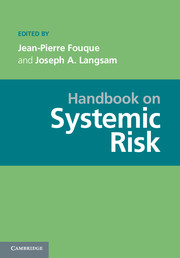Book contents
- Frontmatter
- Contents
- Contributors
- Introduction
- PART I DATA: THE PREREQUISITE FOR MANAGING SYSTEMIC RISK
- 1 Systemic Risk Information Requirements: Current Environment, Needs, and Approaches for Development
- 2 Aligning Models and Data for Systemic Risk Analysis
- 3 Applying FpML
- 4 Data Integration for Systemic Risk in the Financial System
- 5 Semantics in Systemic Risk Management
- PART II STATISTICS AND SYSTEMIC RISK
- PART III MEASURING AND REGULATING SYSTEMIC RISK
- PART IV NETWORKS
- PART V SYSTEMIC RISK ANDMATHEMATICAL FINANCE
- PART VI COUNTERPARTY RISK AND SYSTEMIC RISK
- PART VII ALGORITHMIC TRADING
- PART VIII BEHAVIORAL FINANCE: THE PSYCHOLOGICAL DIMENSION OF SYSTEMIC RISK
- PART IX REGULATION
- PART X COMPUTATIONAL ISSUES AND REQUIREMENTS
- PART XI ACCOUNTING ISSUES
- References
4 - Data Integration for Systemic Risk in the Financial System
from PART I - DATA: THE PREREQUISITE FOR MANAGING SYSTEMIC RISK
Published online by Cambridge University Press: 05 June 2013
- Frontmatter
- Contents
- Contributors
- Introduction
- PART I DATA: THE PREREQUISITE FOR MANAGING SYSTEMIC RISK
- 1 Systemic Risk Information Requirements: Current Environment, Needs, and Approaches for Development
- 2 Aligning Models and Data for Systemic Risk Analysis
- 3 Applying FpML
- 4 Data Integration for Systemic Risk in the Financial System
- 5 Semantics in Systemic Risk Management
- PART II STATISTICS AND SYSTEMIC RISK
- PART III MEASURING AND REGULATING SYSTEMIC RISK
- PART IV NETWORKS
- PART V SYSTEMIC RISK ANDMATHEMATICAL FINANCE
- PART VI COUNTERPARTY RISK AND SYSTEMIC RISK
- PART VII ALGORITHMIC TRADING
- PART VIII BEHAVIORAL FINANCE: THE PSYCHOLOGICAL DIMENSION OF SYSTEMIC RISK
- PART IX REGULATION
- PART X COMPUTATIONAL ISSUES AND REQUIREMENTS
- PART XI ACCOUNTING ISSUES
- References
Summary
Abstract The need to integrate data from many sources is likely to be a key bottleneck in the analysis of systemic risk. Oversimplified approaches result in large amounts of code being written and maintained by hand, and many software engineers having access to sensitive data. We describe the separate dimensions of the problem – many “silver bullets” only address one or two. We explain why it is neither feasible nor desirable to use a single standard for all data sharing for financial research, and then explore the pros and cons of standards at different levels of detail. We then explore some of the tools needed to implement and evolve a set of data exchanges. Finally, we discuss how data difficulties raise important research issues for both financial analysis experts and computer scientists.
The systemic risk data integration challenge
Systemic risk analysis in the financial sector requires massive data integration. Information must be collected from hundreds (and ultimately, perhaps, thousands) of financial firms, corresponding entities must be matched, and all the data must be transformed to meet the needs of systemic risk analysis models. The Dodd–Frank act established an Office of Financial Research (OFR) and gave it the mission of collecting, integrating, and analyzing diverse data in order to better track and analyze financial systemic risk. The data integration challenge is daunting and, if handled poorly, will be a significant impediment to the OFR being able to do systemic analyses.
Information
- Type
- Chapter
- Information
- Handbook on Systemic Risk , pp. 93 - 122Publisher: Cambridge University PressPrint publication year: 2013
References
Accessibility standard: Unknown
Why this information is here
This section outlines the accessibility features of this content - including support for screen readers, full keyboard navigation and high-contrast display options. This may not be relevant for you.Accessibility Information
- 1
- Cited by
